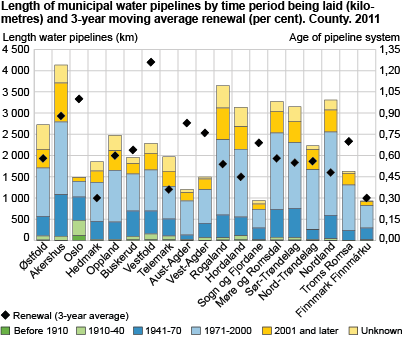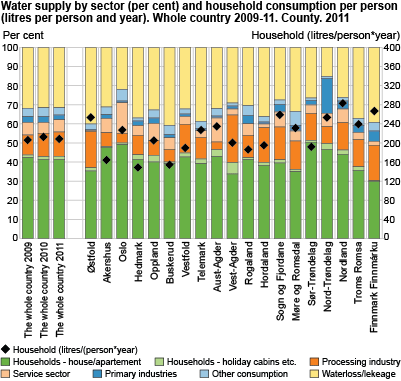Content
Published:
This is an archived release.
0.6 per cent renewal of the pipeline system
The renewal of municipal water pipelines varies from one year to another. Calculated as a 3-year moving average for the period 2009-2011, the rate of renewal is 0.6 per cent of the total pipeline system - the same level as the year before.
Today’s renewal rate means that it will take almost 160 years to renew the whole pipeline system, assuming that no new pipelines are installed in the coming years. It has been estimated that, overall, 1 leaking repair took place per 10 kilometres.
Half the pipeline system from 1971-2000
The length of the municipal water pipelines is estimated at nearly 43 900 kilometres; the same as the earth’s circumference at the equator. Around 50 per cent of the municipal pipeline system was laid between 1971 and 2000. Furthermore, around 4 per cent was laid before 1940 and 24 per cent before 1970. There are large differences in the age and quality of the pipeline system between municipalities.
The age of the pipeline system for the country as a whole is estimated at 31 years. If corrected for pipelines laid in an “unknown time period”, the estimate changes to 33 years.
Drinking water under “pressure”
Booster pumps are used in many areas of Norway in order to transport drinking water to consumers. There are a total of 2 287 such pumps in the country, which corresponds to an average of 1 booster pump every 20 kilometres of water pipelines. If the pressure was to drop, there is a risk that polluted water from the outside may come into contact with the drinking water inside the pipelines. Thus, it is important to reduce pressure drops to a minimum by renewing old pipelines and having good routines for planned stops in the water supply.
209 litres a day per person
KOSTRA statistics on water supply show that more than 41 per cent of water to the municipal water pipeline system is consumed by households. An additional 2 per cent is consumed in holiday cottages or holiday homes. In one year, this means 209 litres a day per person - a 4 litre decrease compared to 2010.
Altogether, the municipal waterworks produced 740 million m3 of water, compared to 744 million m3 in 2010. One out of three litres, or around 32 per cent, of the water supplied are “lost” through leakage.
Satisfactory water quality
Around 4.2 million inhabitants in Norway were connected to the 1 078 municipal water works located in the country. This corresponds to 84.1 per cent of Norway’s population.
In 2011, a total of 99, 81 and 94 per cent respectively were connected to municipal waterworks that provided water with satisfactory content of thermo-tolerant intestinal bacteria ( E . coli ), colour and levels of acidity (pH).
Contact
-
Gisle Berge
E-mail: gisle.berge@ssb.no
tel.: (+47) 48 12 19 97


